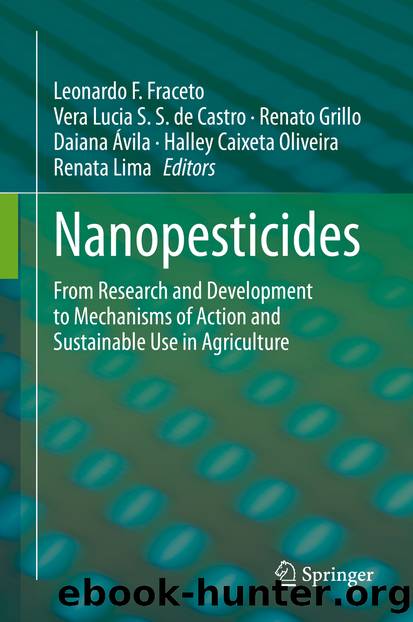Nanopesticides by Unknown

Author:Unknown
Language: eng
Format: epub
ISBN: 9783030448738
Publisher: Springer International Publishing
5 Natural Minerals
Diatomaceous earth (DE) is nearly pure amorphous SiO2, fabricated of fossilized diatoms showing insecticidal activity. It can absorb epicuticular lipids and fatty acids causing desiccation in arthropods (Shah and Khan 2014). Particles of insecticidal DE with diameters <10 μm, pH <8.5, marginal number of clay particles, and <1% crystalline SiO2 could be easily picked up by rough bodied insects, and the cuticule damaged by hydrocarbon absorption and abrasion will be permeable to water and the insects die from desiccation (Korunic 1998). The toxicity of SiO2 and Al2O3 NPs to insects is also connected with their binding to the insect cuticle, and following physical sorption of waxes and lipids causes dehydration of the organism (Benelli 2018a). The insecticidal activity of several porous materials including diatomaceous earth and zeolites against pharaoh ant (Monomorium pharaonis) depended predominantly on macroporous surface area and Brunauer–Emmett–Teller (BET) specific surface area, and the removal of the protective epicuticular hydrocarbons resulted in the mortality of insects (Van den Noortgate et al. 2018).
On the other hand, nanoscale zeolites could reduce the bioavailability of synthetic insecticides due to their sorption properties that results in reduced toxicity of the insecticide (Lorenz et al. 2017a). Exposure of eggs of tomato leafminer T. absoluta to zeolites showed adverse effect on the development process reflected in the weakening the first instar larvae and increased mortality (De Smedt et al. 2016). In crop protection zeolites are predominantly used as carriers of different active ingredients in slow-release applications (De Smedt et al. 2015).
Using DE Debnath et al. (2010) prepared Al2O3 NPs and amorphous SiO2 NPs showing strong activity against mustard aphid (Lipaphis pseudobrassicae); however, Al2O3 NPs adversely affected the growth of mustard crops. On the other hand, the insecticidal activity of TiO2 NPs against mustard aphid was only moderate. Bioactivity of DE against various insects such as the subterranean termite Reticulitermes chinensis Snyder (Isoptera: Rhinotermitidae) (Gao et al. 2018b), storage pests Liposcelis paeta, Cryptolestes ferrugineus, R. dominica, and T. castaneum (Saeed et al. 2018), lesser mealworm (Alphitobius diaperinus Panzer, 1797 [Coleoptera: Tenebrionidae]) (Oliveira et al. 2017) or Acanthoscelides obtectus (Say) on chickpeas (Cicer arientum L.) (Alkani et al. 2019) and insecticidal potential of zeolites against S. oryzae and Oryzaephilus surinamensis (Eroglu et al. 2019) or Acanthoscelides obtectus (Floros et al. 2018) was reported as well.
Entomotoxicity of amorphous hydrophilic, hydrophobic, and lipophilic SiO2 NPs (15–30 nm) against rice weevil S. oryzae exceeded that of bulk SiO2 particles (>1 μm) causing >90% mortality of insects (Debnath et al. 2011). The pulse seeds of Cajanus cajan, Macrotyloma uniflorum, Vigna mungo, Vigna radiata, C. arietinum, and Vigna unguiculata treated with SiO2 NPs were found to be protected to a great extent against the infestation of stored pulse beetle, Callosobruchus maculatus, which was reflected in strong reduction in oviposition, adult emergence, and seed damage potential, whereby the treatment did not affect the soil microflora. Complete suppression of insect growth was observed in the treated seeds of pigeon pea (Arumugam et al. 2016). In a laboratory experiment Shoaib et al. (2018b) investigated the entomotoxic effects of SiO2 NPs in form of dust on larvae of P.
Download
This site does not store any files on its server. We only index and link to content provided by other sites. Please contact the content providers to delete copyright contents if any and email us, we'll remove relevant links or contents immediately.
| Automotive | Engineering |
| Transportation |
Whiskies Galore by Ian Buxton(41888)
Introduction to Aircraft Design (Cambridge Aerospace Series) by John P. Fielding(33064)
Small Unmanned Fixed-wing Aircraft Design by Andrew J. Keane Andras Sobester James P. Scanlan & András Sóbester & James P. Scanlan(32744)
Craft Beer for the Homebrewer by Michael Agnew(18146)
Turbulence by E. J. Noyes(7943)
The Complete Stick Figure Physics Tutorials by Allen Sarah(7312)
Kaplan MCAT General Chemistry Review by Kaplan(6868)
The Thirst by Nesbo Jo(6834)
Bad Blood by John Carreyrou(6559)
Modelling of Convective Heat and Mass Transfer in Rotating Flows by Igor V. Shevchuk(6392)
Learning SQL by Alan Beaulieu(6215)
Weapons of Math Destruction by Cathy O'Neil(6152)
Man-made Catastrophes and Risk Information Concealment by Dmitry Chernov & Didier Sornette(5926)
Digital Minimalism by Cal Newport;(5670)
Life 3.0: Being Human in the Age of Artificial Intelligence by Tegmark Max(5479)
iGen by Jean M. Twenge(5368)
Secrets of Antigravity Propulsion: Tesla, UFOs, and Classified Aerospace Technology by Ph.D. Paul A. Laviolette(5311)
Design of Trajectory Optimization Approach for Space Maneuver Vehicle Skip Entry Problems by Runqi Chai & Al Savvaris & Antonios Tsourdos & Senchun Chai(5012)
Pale Blue Dot by Carl Sagan(4917)
